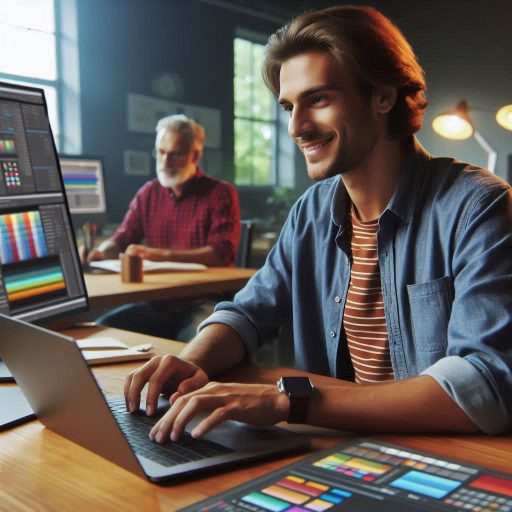Introduction
Motion graphics design blends graphic design with animation.
It creates dynamic visuals that captivate audiences.
Designers use various tools and techniques to produce engaging content.
This field plays a significant role in advertising, entertainment, and education.
In recent years, motion graphics have gained popularity.
Businesses increasingly utilize them to communicate ideas effectively.
They enhance storytelling and engage viewers in memorable ways.
As technology evolves, so does the art of motion graphics design.
Designers must adapt to these changes to stay competitive.
Staying updated with industry trends is crucial for motion graphic designers.
The digital landscape is fast-paced, and new tools emerge regularly.
Following trends helps designers maintain relevance and appeal.
Understanding current styles allows them to create fresh, impactful content.
Emerging technologies influence motion graphics design significantly.
For instance, augmented reality (AR) and virtual reality (VR) open new creative avenues.
Designers can now create immersive experiences that captivate audiences.
Staying informed about these advancements helps designers explore innovative solutions.
Additionally, animation styles evolve as culture shifts.
Flat design and 3D animation have gained traction recently.
Designers should be aware of these trends to cater to diverse audiences.
Integrating popular styles can enhance a project‘s visual appeal and effectiveness.
Rising demand for personalized and interactive content
In 2024, the demand for personalized and interactive content is rapidly increasing.
Consumers no longer settle for passive viewing experiences.
They seek engaging and customized interactions with brands.
This shift drives motion graphics design to the forefront of digital marketing strategies.
Consumers Seek More Engaging and Customized Experiences
Consumers today prefer experiences that reflect their unique preferences.
They are drawn to brands that recognize their individuality and cater to it.
Motion graphics allow brands to create experiences that feel bespoke and relevant.
This approach differentiates brands in an increasingly crowded marketplace.
As attention spans dwindle, brands must find innovative ways to capture interest.
Motion graphics provide a dynamic solution that combines creativity with user engagement.
Brands can use animations to convey complex messages quickly and effectively.
By integrating interactive elements, they enhance viewer participation and retention.
Furthermore, personalized motion graphics can lead to higher conversion rates.
Engaging animations can guide consumers through the decision-making process.
They create compelling calls to action that drive user engagement.
When consumers feel connected to a brand, they are more likely to make a purchase.
Motion Graphics Design Can Help Brands Stand Out in a Crowded Marketplace
As brands invest in motion graphics, they harness the power of storytelling.
Animated stories resonate emotionally with viewers, making the message more memorable.
Brands can use motion graphics to convey their mission, values, and unique selling points effectively.
In addition, social media platforms prioritize engaging content.
Brands that leverage motion graphics can gain more visibility and reach.
Eye-catching animations attract users’ attention, increasing the likelihood of shares and likes.
This organic promotion helps brands expand their audience and build a loyal following.
Emerging technologies like augmented reality (AR) and virtual reality (VR) enhance motion graphics possibilities.
These technologies allow brands to create immersive experiences that captivate audiences.
Users can engage with content in novel ways, transforming how they interact with brands.
In essence, the rising demand for personalized and interactive content drives motion graphics design in 2024.
By creating customized and interactive content, brands can foster deeper connections and drive engagement.
Adapting to these trends is essential for brands seeking to thrive in today‘s competitive landscape.
Integration of virtual and augmented reality in motion graphics design
The motion graphics design industry is rapidly evolving.
In 2024, the integration of virtual reality (VR) and augmented reality (AR) significantly shapes its landscape.
Designers increasingly leverage these technologies to create immersive experiences.
VR and AR offer exciting new dimensions for storytelling.
They allow creators to engage audiences in unique and interactive ways.
Growing Popularity of VR and AR Technologies
The growing popularity of VR and AR technologies fuels this trend.
As hardware becomes more accessible, more users adopt these experiences.
Companies now recognize the potential of VR and AR in marketing and communication.
Brands are investing heavily in immersive content to capture audience attention.
This shift changes how designers approach their projects.
Designers can now create layered narratives that transcend traditional boundaries.
Users can explore environments or interact with characters through their devices.
This interactivity enhances user engagement and retention.
Viewers are no longer passive recipients of information; they actively participate in the story.
This paradigm shift drives innovation in motion graphics design.
Furthermore, VR and AR facilitate personalized experiences.
Designers can tailor content to meet individual preferences.
This customization fosters a deeper connection between users and the brand.
As a result, companies see higher conversion rates and improved customer loyalty.
Opportunities for Innovative Storytelling and User Engagement
Innovative storytelling emerges as a key focus in motion graphics design.
Creators use VR and AR to build dynamic narratives that respond to user actions.
These experiences encourage exploration, discovery, and emotional connection.
Designers can craft multi-sensory environments that evoke strong reactions.
Audiences are drawn into narratives in ways that traditional media cannot achieve.
Additionally, educational applications of VR and AR in motion graphics are on the rise.
Educational institutions use immersive content to enhance learning experiences.
Students engage with complex subjects through interactive simulations.
This hands-on approach fosters better understanding and retention of information.
Designers play a crucial role in developing these educational tools.
Moreover, the film and entertainment industries increasingly adopt VR and AR in their projects.
Filmmakers experiment with immersive storytelling techniques.
They create interactive experiences that allow viewers to choose their narrative paths.
This level of engagement transforms the audience’s relationship with the content.
In general, the integration of virtual and augmented reality in motion graphics design marks a pivotal shift in the industry.
As these technologies gain popularity, they offer opportunities for innovative storytelling and user engagement.
Designers must adapt to this evolving landscape to stay relevant.
Embracing VR and AR can lead to groundbreaking creative possibilities and immersive experiences.
The future of motion graphics design is bright, driven by these exciting advancements.
Read: Essential Skills for Aspiring Costume Designers
Shift towards minimalistic and clean design aesthetics
Minimalistic and clean design aesthetics are dominating the motion graphics industry in 2024.
Designers are moving away from overly complex visuals and embracing simplicity.
This shift stems from the growing need for clear and effective communication.
The focus is now on delivering messages quickly without overwhelming the viewer.
Emphasis on Simplicity and Effectiveness in Communication
In this trend, unnecessary details are stripped away to allow core messages to shine.
Designers prioritize clarity and precision over flashy effects or heavy embellishments.
Minimalistic motion graphics rely on clean lines, balanced layouts, and limited color palettes to create visually appealing and functional designs.
With this emphasis on simplicity, audiences can digest information faster and more efficiently.
Designers are mindful of audience attention spans, especially in a world where quick consumption of content is paramount.
Motion graphics must engage viewers immediately, and minimalism offers a direct route to that goal.
Typography plays a significant role in this shift toward minimalism.
Designers use bold, sans-serif fonts that are easy to read and visually striking.
Pairing typography with ample white space enhances the design‘s readability and aesthetic appeal.
This trend also emphasizes effectiveness in communication.
Brands are recognizing the power of less being more.
Motion graphics are no longer just about visual appeal; they serve a strategic purpose in conveying key messages quickly.
Every design element, from color choice to movement, is carefully selected to communicate clearly and concisely.
Trend Towards Sleek and Modern Design Elements
Sleek and modern design elements complement this trend, offering a futuristic and polished feel.
These elements often include smooth transitions, geometric shapes, and subtle animations.
Motion graphics in 2024 favor a more refined and streamlined look, appealing to tech-savvy audiences and brands.
The rise of mobile platforms has also influenced this shift.
As more content is consumed on smaller screens, motion graphics must adapt to ensure clarity and effectiveness.
A clean design ensures that messaging remains impactful, regardless of the screen size or platform.
Minimalistic designs reduce visual clutter, making the user experience smoother.
As a result, we see a growing preference for motion graphics that prioritize function alongside form.
This blend of sleek, modern design with a minimalistic approach makes content more accessible, engaging, and memorable.
Brands that adopt these trends are better positioned to stand out in an increasingly crowded digital landscape.
In 2024, the motion graphics industry continues to embrace the mantra of “less is more.
” Simplicity, paired with thoughtful design, creates a powerful combination that resonates with modern audiences.
Read: Building a Portfolio for Costume Design

Collaboration between Motion Graphics Designers and Other Professionals
In 2024, collaboration is crucial for motion graphics designers.
Working with other professionals enhances creativity and drives innovation.
Designers frequently partner with marketers, animators, and sound engineers.
These collaborations lead to high-quality, engaging projects that capture audience attention.
Importance of Interdisciplinary Teamwork for Successful Projects
Interdisciplinary teamwork fosters unique perspectives and ideas.
Each professional brings their expertise to the table, enriching the design process.
For instance, a designer can enhance a marketer’s vision through visual storytelling.
Likewise, input from sound engineers can significantly improve the overall experience.
This synergy results in captivating content that resonates with viewers.
Need for Effective Communication and Project Management Skills
Effective communication is vital in these collaborations.
Motion graphics designers must clearly convey their ideas and vision.
Similarly, they must actively listen to feedback from other team members.
This exchange of thoughts leads to a more cohesive project.
Regular meetings and updates ensure everyone stays aligned with project goals.
Project management skills are equally important.
Designers must efficiently organize tasks and deadlines.
They should balance creativity with the practical aspects of project execution.
A well-managed project runs smoothly and meets its objectives.
Understanding each team member’s role can help streamline the workflow.
Technology continues to evolve, making interdisciplinary teamwork even more essential.
Motion graphics designers often use advanced software that requires collaboration.
Learning to navigate these tools together enhances productivity.
Familiarity with project management software also aids in tracking progress and deadlines.
In 2024, the demand for motion graphics continues to grow.
Companies seek professionals who can collaborate effectively with various disciplines.
The ability to work well with others can set a designer apart in a competitive market.
Employers value candidates with strong communication and teamwork skills.
These attributes demonstrate a designer‘s ability to contribute to larger projects.
Building relationships within a team creates a positive working environment.
Designers should invest time in understanding their colleagues‘ strengths and weaknesses.
This knowledge fosters collaboration and improves overall project quality.
A supportive atmosphere encourages creativity and innovation, leading to better results.
In short, collaboration between motion graphics designers and other professionals is essential in 2024.
Interdisciplinary teamwork drives creative projects and ensures successful outcomes.
Designers must prioritize effective communication and project management skills.
These elements will help them thrive in a rapidly changing industry.
By embracing collaboration, designers can elevate their work and meet the evolving demands of the market.
Read: Breaking Down Iconic Movie Costumes
Impact of social media and short-form content on motion graphics design
The impact of social media and short-form content on motion graphics design is undeniable.
Platforms like TikTok and Instagram Reels have revolutionized how designers create content.
These platforms prioritize short, engaging videos that capture attention within seconds.
As a result, motion graphics design has evolved to meet the demand for fast-paced, visually compelling content.
Rise of Platforms Like TikTok and Instagram Reels
Social media has shifted the focus to brevity and impact.
Designers must create motion graphics that communicate a message quickly.
This shift requires motion graphics to be more concise, engaging, and visually appealing.
Attention spans are shorter, so every frame must count.
TikTok and Instagram Reels have played a huge role in this transformation.
Both platforms encourage users to create and share short-form videos, often under 60 seconds.
Motion graphic designers are now tasked with delivering their messages in even shorter time frames.
This change has led to the rise of snappy, dynamic visuals that immediately grab viewers’ attention.
Adaptation of Design Techniques for Quick and Engaging Content Consumption
The rise of these platforms has also introduced new trends in design techniques.
Designers are now focusing on bold typography, vibrant colors, and quick transitions.
These techniques ensure that content remains engaging and visually stimulating in short bursts.
Subtle, slow animations are less effective on platforms where quick scrolling is the norm.
Adaptation has become a key factor in this evolution.
Designers must adapt their styles to meet the demands of short-form content.
This includes creating templates that are easy to modify for different brands or products.
Designers also need to focus on maintaining brand consistency while delivering eye-catching motion graphics.
In response to these trends, many motion graphic designers have started adopting a mobile-first approach.
Since most short-form content is consumed on smartphones, motion graphics are optimized for small screens.
Vertical video formats are prioritized to ensure compatibility with social media feeds.
This trend allows designers to reach a broader audience while maximizing engagement.
Social media trends have also encouraged a more collaborative approach to design.
Designers often work with content creators and influencers to produce motion graphics that resonate with their target audience.
This collaboration ensures that the graphics align with popular trends and consumer preferences.
Most importantly, the rise of social media platforms like TikTok and Instagram Reels has significantly impacted motion graphics design.
Designers have adapted their techniques to create quick, engaging, and visually dynamic content.
As short-form content continues to dominate, the demand for innovative motion graphics will only grow.
Motion graphics designers must stay agile, embracing new trends to remain relevant in this fast-evolving industry.
, and visually striking.
By staying on top of industry trends and embracing new creative approaches, motion graphics designers can continue to thrive in the ever-evolving digital landscape.
Read: Visual Merchandising: Best Practices for Beginners
Transform Your Career Today
Unlock a personalized career strategy that drives real results. Get tailored advice and a roadmap designed just for you.
Start NowExplore Further: Famous Jewelry Designers to Follow
Emphasis on Sustainability and Ethical Design Practices
The motion graphics design industry in 2024 places a strong emphasis on sustainability and ethical practices.
Consumers are increasingly demanding environmentally friendly products and messages in visual media.
Designers must now integrate sustainability into their creative processes.
Incorporating ethical design practices ensures a brand‘s message resonates with eco-conscious audiences.
This shift reflects a broader global movement toward responsible consumption and environmental awareness.
Consumer demand for environmentally friendly products and messages
Sustainability has become a crucial consideration in motion graphics design.
Designers are expected to use resources efficiently and reduce waste in the creative process.
This includes minimizing energy consumption and using tools that leave a lower carbon footprint.
Many designers are adopting software and hardware that prioritize energy efficiency, helping to reduce the environmental impact of their work.
Additionally, using sustainable materials in the production of physical elements is becoming a standard practice.
The demand for eco-friendly products also affects the types of content being created.
Consumers today favor brands that align with their values, especially when it comes to environmental responsibility.
Motion graphics designs that promote sustainable practices, such as recycling or reducing plastic use, are more likely to engage audiences.
Brands that embrace sustainability in their messaging can build stronger connections with their customers.
As a result, designers are increasingly focused on developing visuals that communicate environmental responsibility.
Importance of incorporating ethical considerations into design decisions
Ethical considerations are equally important in today‘s design landscape.
Designers must be mindful of the social and environmental impacts of their creative decisions.
This involves ensuring that the content they create promotes inclusivity and fairness.
Ethical design also means avoiding harmful stereotypes and misleading representations in visual media.
Designers must strive to create content that not only looks good but also promotes positive values.
Incorporating sustainability and ethical design into motion graphics requires a balance between creativity and responsibility.
Designers need to stay innovative while ensuring their work aligns with the growing demand for ethical practices.
This includes being transparent about design processes and choices, ensuring that ethical and sustainable considerations guide every stage of development.
The future of motion graphics design will continue to be shaped by these important trends.
Sustainability and ethical practices are not passing fads but essential elements in creating content that resonates with today‘s audiences.
Designers who prioritize these values are better positioned to succeed in an increasingly eco-conscious and socially responsible market.
By embracing sustainable and ethical design practices, motion graphics professionals can help lead the way toward a more responsible future for the industry.
Explore Further: Tools Every Jewelry Designer Needs
Delve into the Subject: Continuing Education for Industrial Designers
Conclusion
As we look ahead to the future of motion graphics design in 2024, it is essential to recap some key industry trends that are shaping the landscape.
From AI integration to interactive design elements, staying informed and adaptable is crucial for designers to thrive in this ever-evolving field.
By keeping up with the latest technologies and tools, designers can enhance their skillset and create compelling visual stories that resonate with audiences.
Embracing the shift towards more personalized and immersive experiences will be key to staying relevant and competitive in the industry.
As we navigate through the dynamic world of motion graphics design, it is important to embrace change and innovation.
By continuously learning and growing, designers can push the boundaries of creativity and drive the industry forward.
2024 promises to be an exciting year for motion graphics design, with new opportunities for innovation and collaboration on the horizon.
By staying informed, adaptable, and open to change, designers can position themselves for success in this fast-paced and ever-changing industry.




